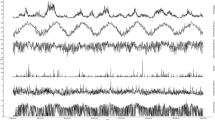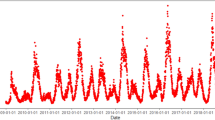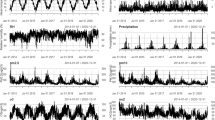Abstract
Hand, foot, and mouth disease (HFMD) is one of the most common communicable diseases in China, and current climate change had been recognized as a significant contributor. Nevertheless, no reliable models have been put forward to predict the dynamics of HFMD cases based on short-term weather variations. The present study aimed to examine the association between weather factors and HFMD, and to explore the accuracy of seasonal auto-regressive integrated moving average (SARIMA) model with local weather conditions in forecasting HFMD. Weather and HFMD data from 2009 to 2014 in Huainan, China, were used. Poisson regression model combined with a distributed lag non-linear model (DLNM) was applied to examine the relationship between weather factors and HFMD. The forecasting model for HFMD was performed by using the SARIMA model. The results showed that temperature rise was significantly associated with an elevated risk of HFMD. Yet, no correlations between relative humidity, barometric pressure and rainfall, and HFMD were observed. SARIMA models with temperature variable fitted HFMD data better than the model without it (sR 2 increased, while the BIC decreased), and the SARIMA (0, 1, 1)(0, 1, 0)52 offered the best fit for HFMD data. In addition, compared with females and nursery children, males and scattered children may be more suitable for using SARIMA model to predict the number of HFMD cases and it has high precision. In conclusion, high temperature could increase the risk of contracting HFMD. SARIMA model with temperature variable can effectively improve its forecast accuracy, which can provide valuable information for the policy makers and public health to construct a best-fitting model and optimize HFMD prevention.





Similar content being viewed by others
References
Chen C, Lin H, Li X, Lang L, Xiao X, Ding P, He P, Zhang Y, Wang M, Liu Q (2014) Short-term effects of meteorological factors on children hand, foot and mouth disease in Guangzhou, China. Int J Biometeorol 58(7):1605–1614
Cheng J, Wu J, Xu Z, Zhu R, Wang X, Li K, Wen L, Yang H, Su H (2014) Associations between extreme precipitation and childhood hand, foot and mouth disease in urban and rural areas in Hefei, China. Sci Total Environ 497-498:484–490
Chua KB, Kasri AR (2011) Hand foot and mouth disease due to enterovirus 71 in Malaysia. Virol Sin 26(4):221–228
Earnest A, Chen MI, Ng D, Sin LY (2005) Using autoregressive integrated moving average (ARIMA) models to predict and monitor the number of beds occupied during a SARS outbreak in a tertiary hospital in Singapore. BMC Health Serv Res 5:36
Eswaran C, Logeswaran R (2012) An enhanced hybrid method for time series prediction using linear and neural network models. Appl Intell 37:511–519
Fujimoto T, Iizuka S, Enomoto M, Abe K, Yamashita K, Hanaoka N, Okabe N, Yoshida H, Yasui Y, Kobayashi M, Fujii Y, Tanaka H, Yamamoto M, Shimizu H (2012) Hand, foot, and mouth disease caused by coxsackievirus A6, Japan, 2011. Emerg Infect Dis 18(2):337–339
Gasparrini A, Armstrong B, Kenward MG (2010) Distributed lag non-linear models. Stat Med 29(21):2224–2234
Ho M, Chen ER, Hsu KH, Twu SJ, Chen KT, Tsai SF, Wang JR, Shih SR (1999) An epidemic of enterovirus 71 infection in Taiwan. Taiwan Enterovirus Epidemic Working Group. N Engl J Med 341(13):929–935
Huang Y, Deng T, Yu S, Gu J, Huang C, Xiao G, Hao Y (2013) Effect of meteorological variables on the incidence of hand, foot, and mouth disease in children: a time-series analysis in Guangzhou, China. BMC Infect Dis 13:134
IPCC (2001) Climate change 2001: the scientific basis. Contribution of working group I to the third assessment report of the Intergovernmental Panel on Climate Change. Cambridge University Press, Cambridge
Li GZ, Shao FF, Zhang H, Zou CP, Li HH, Jin J (2015) High mean water vapour pressure promotes the transmission of bacillary dysentery. PLoS One 10(5):e0124478
Liu W, Ji H, Shan J, Bao J, Sun Y, Li J, Bao C, Tang F, Yang K, Bergquist R, Peng Z, Zhu Y (2015a) Spatiotemporal dynamics of hand-foot-mouth disease and its relationship with meteorological factors in Jiangsu Province, China. PLoS One 10(6):e0131311
Liu Q, Liu X, Jiang B, Yang W (2011) Forecasting incidence of hemorrhagic fever with renal syndrome in China using ARIMA model. BMC Infect Dis 11:218
Liu L, Luan RS, Yin F, Zhu XP, Lü Q (2015b) Predicting the incidence of hand, foot and mouth disease in Sichuan province, China using the ARIMA model. Epidemiol Infect:1–8.
Ljung GM, Box GEP (1978) On a measure of lack of fit in time series models. Biometrika 65:297–303
Martinez EZ, Silva EA (2011) Predicting the number of cases of dengue infection in Ribeirão Preto, São Paulo State, Brazil, using a SARIMA model. Cad Saude Publica 27(9):1809–1818
Meerburg BG, Kijlstra A (2009) Changing climate-changing pathogens: Toxoplasma gondii in North-Western Europe. Parasitol Res 105(1):17–24
Nguyen NT, Pham HV, Hoang CQ, Nguyen TM, Nguyen LT, Phan HC, Phan LT, Vu LN, Tran Minh NN (2014) Epidemiological and clinical characteristics of children who died from hand, foot and mouth disease in Vietnam, 2011. BMC Infect Dis 14:341
Onozuka D, Hashizume M (2011) The influence of temperature and humidity on the incidence of hand, foot, and mouth disease in Japan. Sci Total Environ 410-411:119–125
Patz JA, Olson SH (2006) Malaria risk and temperature: influences from global climate change and local land use practices. Proc Natl Acad Sci U S A 103(15):5635–5636
Patz JA, Campbell-Lendrum D, Holloway T, Foley JA (2005) Impact of regional climate change on human health. Nature 438(7066):310–317
Patz JA, Frumkin H, Holloway T, Vimont DJ, Haines A (2014) Climate change: challenges and opportunities for global health. JAMA 312(15):1565–1580
Phung D, Huang C, Rutherford S, Chu C, Wang X, Nguyen M, Nguyen NH, Manh CD, Nguyen TH (2015) Association between climate factors and diarrhoea in a Mekong Delta area. Int J Biometeorol 59(9):1321–1331
Urashima M, Shindo N, Okabe N (2003) Seasonal models of herpangina and hand-foot- mouth disease to simulate annual fluctuations in urban warming in Tokyo. Jpn J Infect Dis 56(2):48–53
Wei J, Hansen A, Liu Q, Sun Y, Weinstein P, Bi P (2015) The effect of meteorological variables on the transmission of hand, foot and mouth disease in four major cities of Shanxi province, China: a time series data analysis (2009–2013). PLoS Negl Trop Dis 9(3):e0003572
Wong J, Chan A, Chiang YH (2005) Time series forecasts of the construction labour market in Hong Kong: the box-Jenkins approach. Construction Manag Econ 23:979–991
Wu Y, Yeo A, Phoon MC, Tan EL, Poh CL, Quak SH, Chow VT (2010) The largest outbreak of hand, foot and mouth disease in Singapore in 2008: the role of enterovirus 71 and coxsackievirus a strains. Int J Infect Dis 14(12):e1076–e1081
Xu Z, Huang C, Su H, Turner LR, Qiao Z, Tong S (2013) Diurnal temperature range and childhood asthma: a time-series study. Environ Health 12:12
Xu M, Yu W, Tong S, Jia L, Liang F, Pan X (2015) Non-linear association between exposure to ambient temperature and Children’s hand-foot-and-mouth disease in Beijing, China. PLoS One 10(5):e0126171
Yang H, Wu J, Cheng J, Wang X, Wen L, Li K, Su H (2015) Is high relative humidity associated with childhood hand, foot, and mouth disease in rural and urban areas? Public Health pii:S0033–3506(15)00135–3.
Zhang Y, Zhu Z, Yang W, Ren J, Tan X, Wang Y, Mao N, Xu S, Zhu S, Cui A, Zhang Y, Yan D, Li Q, Dong X, Zhang J, Zhao Y, Wan J, Feng Z, Sun J, Wang S, Li D, Xu W (2010) An emerging recombinant human enterovirus 71 responsible for the 2008 outbreak of hand foot and mouth disease in Fuyang city of China. Virol J 7:94
Zheng YL, Zhang LP, Zhang XL, Wang K, Zheng YJ (2015) Forecast model analysis for the morbidity of tuberculosis in Xinjiang, China. PLoS One 10(3):e0116832
Acknowledgments
This research was funded by Huainan science and technology plan projects (no. 2015 B44).
Author information
Authors and Affiliations
Corresponding author
Ethics declarations
Conflict of interest
The authors declare that they have no conflict of interest.
Electronic supplementary material
Table S1
(DOC 30 kb)
Table S2
(DOC 30 kb)
Fig. S1
The monthly distribution of HFMD in Huainan, China, during 2009–2014. (DOC 104 kb)
Fig. S2
The lagged effects on HFMD at 95th percentile of temperature (reference at 50th percentile). (DOC 26 kb)
Fig. S3
The ACF and PACF of the residual on weekly data in Model_1 (model without ambient temperature) and Model_2(model with ambient temperature). (DOC 48 kb)
Fig. S4
Results of the prediction models on weekly data in different groups in Huainan. (DOC 150 kb)
Fig. S5
Results of the prediction model on monthly data in Model_1 (model without ambient temperature) and Model_2 (model with ambient temperature). (DOC 92 kb)
Fig. S6
Results of the prediction models on monthly data in different groups in Huainan. (DOC 138 kb)
Rights and permissions
About this article
Cite this article
Zhao, D., Wang, L., Cheng, J. et al. Impact of weather factors on hand, foot and mouth disease, and its role in short-term incidence trend forecast in Huainan City, Anhui Province. Int J Biometeorol 61, 453–461 (2017). https://doi.org/10.1007/s00484-016-1225-9
Received:
Revised:
Accepted:
Published:
Issue Date:
DOI: https://doi.org/10.1007/s00484-016-1225-9




